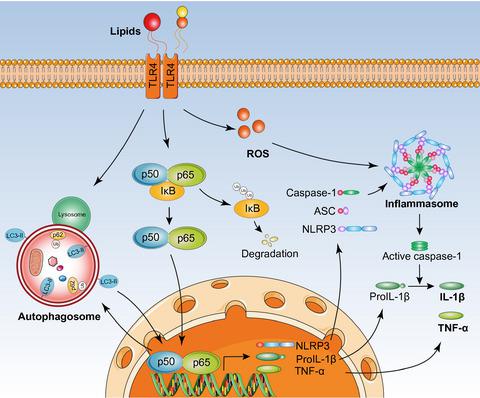当前位置:
X-MOL 学术
›
Clin. Exp. Immunol.
›
论文详情
Our official English website, www.x-mol.net, welcomes your feedback! (Note: you will need to create a separate account there.)
Mycoplasma pneumoniae lipids license TLR4 for activation of NLRP3 inflammasome and autophagy to evoke a proinflammatory response.
Clinical & Experimental Immunology ( IF 4.6 ) Pub Date : 2020-09-07 , DOI: 10.1111/cei.13510 H Luo 1, 2 , J He 2 , L Qin 1 , Y Chen 1 , L Chen 1 , R Li 1 , Y Zeng 1 , C Zhu 1 , X You 1 , Y Wu 1
Clinical & Experimental Immunology ( IF 4.6 ) Pub Date : 2020-09-07 , DOI: 10.1111/cei.13510 H Luo 1, 2 , J He 2 , L Qin 1 , Y Chen 1 , L Chen 1 , R Li 1 , Y Zeng 1 , C Zhu 1 , X You 1 , Y Wu 1
Affiliation

|
Mycoplasma pneumoniae is an obligate pathogen that causes pneumonia, tracheobronchitis, pharyngitis and asthma in humans. It is well recognized that membrane lipoproteins are immunostimulants exerting as lipopolysaccharides (LPS) and play a crucial role in the pathogenesis of inflammatory responses upon M. pneumoniae infection. Here, we report that the M. pneumoniae‐derived lipids are another proinflammatory agents. Using an antibody‐neutralizing assay, RNA interference or specific inhibitors, we found that Toll‐like receptor 4 (TLR‐4) is essential for M. pneumoniae lipid‐induced tumour necrosis factor (TNF)‐α and interleukin (IL)‐1β production. We also demonstrate that NLR family pyrin domain containing 3 inflammasome (NLRP3) inflammasome, autophagy and nuclear factor kappa B (NF‐κB)‐dependent pathways are critical for the secretion of proinflammatory cytokines, while inhibition of TLR‐4 significantly abrogates these events. Further characterization revealed that autophagy‐mediated inflammatory responses involved the activation of NF‐κB. In addition, the activation of NF‐κB promoted lipid‐induced autophagosome formation, as revealed by assays using pharmacological inhibitors, 3‐methyladenine (3‐MA) and Bay 11‐7082, or silencing of atg5 and beclin‐1. These findings suggest that, unlike the response to lipoprotein stimulation, the inflammation in response to M. pneumoniae lipids is mediated by the TLR‐4 pathway, which subsequently initiates the activation of NLRP3 inflammasome and formation of a positive feedback loop between autophagy and NF‐κB signalling cascade, ultimately promoting TNF‐α and Il‐1β production in macrophages.
中文翻译:

肺炎支原体脂质允许 TLR4 激活 NLRP3 炎症小体和自噬以引起促炎反应。
肺炎支原体是引起人类肺炎、气管支气管炎、咽炎和哮喘的专性病原体。众所周知,膜脂蛋白是作为脂多糖 (LPS) 发挥作用的免疫刺激剂,并且在肺炎支原体感染的炎症反应的发病机制中起关键作用。在这里,我们报告肺炎支原体衍生的脂质是另一种促炎剂。使用抗体中和试验、RNA 干扰或特异性抑制剂,我们发现 Toll 样受体 4 (TLR-4) 对肺炎支原体至关重要脂质诱导的肿瘤坏死因子 (TNF)-α 和白细胞介素 (IL)-1β 的产生。我们还证明,包含 3 个炎性体 (NLRP3) 炎性体、自噬和核因子 kappa B (NF-κB) 依赖性途径的 NLR 家族 pyrin 结构域对于促炎细胞因子的分泌至关重要,而抑制 TLR-4 可显着消除这些事件。进一步的表征表明,自噬介导的炎症反应涉及 NF-κB 的激活。此外,NF-κB 的激活促进了脂质诱导的自噬体形成,如使用药理学抑制剂、3-甲基腺嘌呤 (3-MA) 和 Bay 11-7082 或atg5和beclin-1 的沉默所揭示的. 这些发现表明,与对脂蛋白刺激的反应不同,对肺炎支原体脂质的炎症反应是由 TLR-4 通路介导的,该通路随后启动 NLRP3 炎症小体的激活并在自噬和 NF-之间形成正反馈回路。 κB 信号级联,最终促进巨噬细胞中 TNF-α 和 Il-1β 的产生。
更新日期:2020-09-07
中文翻译:

肺炎支原体脂质允许 TLR4 激活 NLRP3 炎症小体和自噬以引起促炎反应。
肺炎支原体是引起人类肺炎、气管支气管炎、咽炎和哮喘的专性病原体。众所周知,膜脂蛋白是作为脂多糖 (LPS) 发挥作用的免疫刺激剂,并且在肺炎支原体感染的炎症反应的发病机制中起关键作用。在这里,我们报告肺炎支原体衍生的脂质是另一种促炎剂。使用抗体中和试验、RNA 干扰或特异性抑制剂,我们发现 Toll 样受体 4 (TLR-4) 对肺炎支原体至关重要脂质诱导的肿瘤坏死因子 (TNF)-α 和白细胞介素 (IL)-1β 的产生。我们还证明,包含 3 个炎性体 (NLRP3) 炎性体、自噬和核因子 kappa B (NF-κB) 依赖性途径的 NLR 家族 pyrin 结构域对于促炎细胞因子的分泌至关重要,而抑制 TLR-4 可显着消除这些事件。进一步的表征表明,自噬介导的炎症反应涉及 NF-κB 的激活。此外,NF-κB 的激活促进了脂质诱导的自噬体形成,如使用药理学抑制剂、3-甲基腺嘌呤 (3-MA) 和 Bay 11-7082 或atg5和beclin-1 的沉默所揭示的. 这些发现表明,与对脂蛋白刺激的反应不同,对肺炎支原体脂质的炎症反应是由 TLR-4 通路介导的,该通路随后启动 NLRP3 炎症小体的激活并在自噬和 NF-之间形成正反馈回路。 κB 信号级联,最终促进巨噬细胞中 TNF-α 和 Il-1β 的产生。


























 京公网安备 11010802027423号
京公网安备 11010802027423号